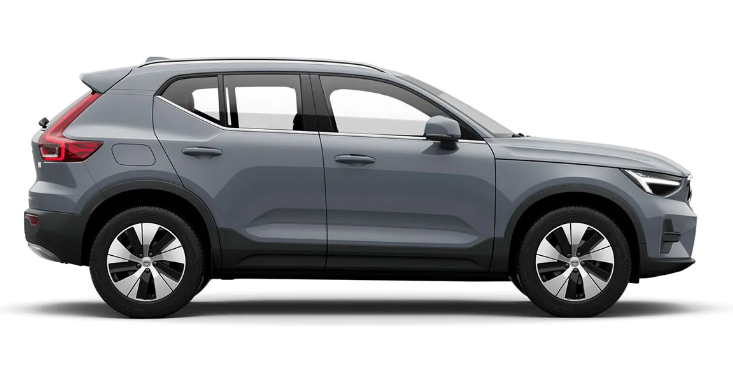Prescribed grade:
Volvo Original or equivalent fluid compliant with a combination of Dot 4, 5.1 and ISO 4925 class 6.
Note
It is recommended that brake fluid is changed or filled by an authorised Volvo workshop.
Brake functions
Depending on the car’s equipment, the following auto braking functions are available:
- Automatic brake when stationary (Auto Hold)
- Hill start assist (Hill Start Assist)
- Auto braking after a collision
- City Safety
- Hill descent control (Hill Descent Control)
Automatic braking when stationary
When braking to a standstill on an uphill or downhill slope, the brake pedal should be depressed a little harder before being released to ensure the car does not roll.
The parking brake is activated if
- the car is switched off
- the driver’s door is opened
- the driver’s seatbelt is unbuckled
- the car has been stationary for a longer time (5-10 minutes).
Auto hold can also change over to the parking brake in other situations.
| Symbol | Specification |
|---|---|
| | The symbol is illuminated when the function uses the foot brake to keep the car stationary. |
| | The symbol is illuminated when the function uses the parking brake to keep the car stationary. |
Activating and deactivating the automatic brake at a standstill
- Press the button in the tunnel console to activate or deactivate the function.
- The indicator in the button illuminates when the function is activated. Activated function remains even when the car is started next time.
If the function is active and holds the car with the foot brake (A-symbol illuminated in the driver display), the brake pedal must be depressed at the same time as the button is depressed in order to deactivate.
- The function remains deactivated until it is reactivated.
- When the function is deactivated, hill start assist (HSA) remains active to prevent the car from rolling backwards when starting on an uphill gradient.
Auto braking after a collision
Help when starting on a hill
Regenerative braking
- The battery symbol is shown in the driver display when the car is generating power for the battery.
- The function is available in all drive modes together with gear position D or M.
Activating brake regeneration
- Brake regeneration is activated by gentle pressure on the brake pedal or during engine braking.
- Regeneration increases during engine braking when manual gearshift mode M is selected.
Low-speed control
- The low-speed control function (LSC) facilitates and improves traction for driving off-road and on slippery surfaces, such as with a caravan on grass or a boat trailer on a launch ramp.
- In a car with a drive mode button, the function is included in the Off Road drive mode.
- The function is adapted for off-road driving and driving with a trailer at low speed, up to approx. 40 km/h (25 mph).
- Low-speed control prioritises low gears and traction. If the car is all-wheel drive, the motive force is distributed evenly in order to provide as good traction as possible on all wheels and to reduce the risk of wheel spin. The accelerator pedal is less responsive in order to facilitate traction and speed control at low speed.
- The function is activated together with hill descent control, (HDC) which means that speed down steep hills can be controlled with the accelerator pedal, reducing the need to use the brake pedal. The system facilitates a low and even speed while driving on steep downhill gradients.
- When LSC with HDC is activated, the feel of the accelerator pedal and engine response are changed.
- The driving mode is not designed to be used on public roads.
- The function is deactivated when driving at higher speeds and must be reactivated at a lower speed, if required.
Hill descent control
Warning
- HDC does not work in all situations but is designed merely as a supplementary aid.
- The driver always bears ultimate responsibility for ensuring that the vehicle is driven safely.
Function
Hill descent control allows the car to roll at inching speed both forward and backward, assisted by the brake system. The speed can be increased by using the accelerator pedal. When the accelerator pedal is then released the car slows back down to crawling speed, regardless of the gradient of the hill and without the need for the foot brake to be used. The brake lights are switched on when the function is operating.The driver can brake and reduce crawling speed, or stop the car at any time by using the foot brake.The function is activated together with low speed control (LSC) which facilitates driving and improves traction for driving off-road and on slippery surfaces. The systems are designed for use at low speed, up to approx. 40 km/h (25 mph).
Points to remember when driving with HDC
- If the function is disabled while driving on a steep downhill gradient, the braking effect will gradually decrease.
With automatic gearbox
- HDC can be used in gear position D, R, and with 1st or 2nd gear with manual gear changing.
- It is not possible to change to 3rd gear or higher with manual gear changing.
With manual gearbox
- HDC only brakes in 1st gear or with reverse gear (R). There is no active braking in higher gears even though the function is not deactivated until approx. 40 km/h (25 mph).
- When LSC with HDC is activated, the feel of the accelerator pedal and engine response are changed.
- The driving mode is not designed to be used on public roads.
- The function is deactivated when driving at higher speeds and must be reactivated at a lower speed, if required.




